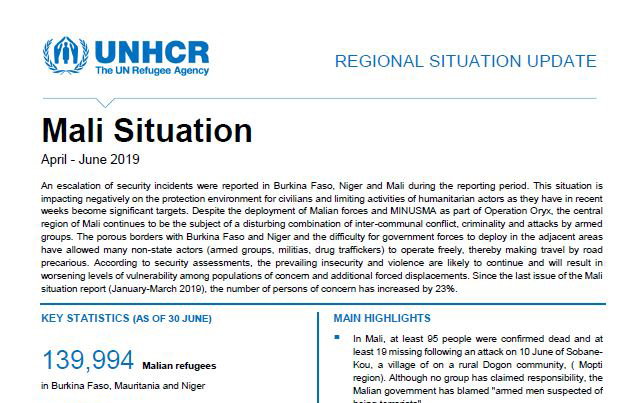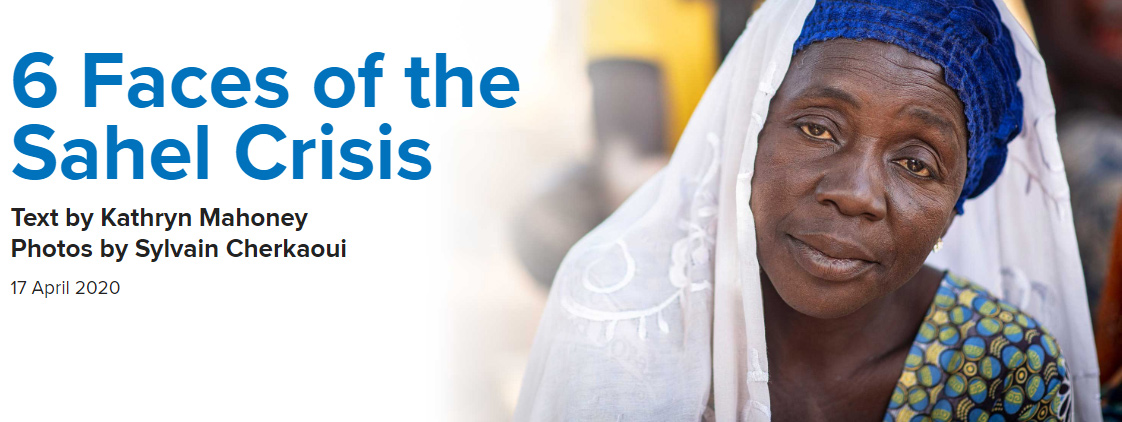Mali
Operation: Mali
Location
{"longitude":-2,"latitude":17,"zoom_level":0,"iso_codes":"'MLI'"}
By clicking on the icons on the map, additional information is displayed.
The boundaries and names shown and the designations used on this map do not imply official endorsement or acceptance by the United Nations.
Key Figures
| 2019 year-end results | |
| 6,500 | returnees (56% of whom were children) benefited from cash assistance to facilitate their reintegration, by reducing vulnerability |
| 1,900 | protection incidents were recorded through protection monitoring, leading to more than 100 urgent referrals to response actors, including the Civil-Military Coordination (CMCOORD), Mali Rapid Response Mechanism actors, actors able to conduct rapid protection assessments, and the MINUSMA Human Rights section |
| 1,100 | registered refugee children benefited from access to education for the 2019-2020 school year. Financial assistance was provided to some 600 families to support enrolment |
| 2020 planning figures | |
| 100% | of returnees’ reintegration is made more sustainable |
| 100% | of people of concern will be registered on an individual basis |
| 100% | of targeted households will have basic needs met with multi-purpose cash grants or vouchers |
| 100% | of refugees living in Mali with intention to return will return voluntarily |
| 100% | of identified people of concern in need of resettlement will be submitted for resettlement |
Latest Updates
People of Concern
79%
Increase in
2019
2019
| 2019 | 275,779 |
| 2018 | 154,432 |
| 2017 | 84,081 |

[["Refugees",26670],["Asylum-seekers",1008],["IDPs",207751],["Returned IDPs",35101],["Returned refugees",5249]]
Loading ...
Mali
< Back
2019
{"categories":[2015,2016,2017,2018,2019,2020],"budget":[67.860516734,49.1719132,41.007531648000004,21.59999173,17.33224968,47.50161438],"expenditure":[14.86664134,13.372276549999999,13.34678074,13.35314797,13.1037125,null]}
{"categories":[2015,2016,2017,2018,2019,2020],"p1":[48.924988311999996,27.08867361,13.625051767999999,11.212450070000001,8.28224972,22.841660079999997],"p2":[0.12311877,1.06694838,0.956948,null,null,null],"p3":[10.754399482,17.77571883,25.28018688,9.26252293,7.449999490000001,9.27332685],"p4":[8.05801017,3.2405723799999997,1.145345,1.12501873,1.60000047,15.386627449999999]}
{"categories":[2015,2016,2017,2018,2019,2020],"p1":[9.3844582,7.040851,5.73030234,7.1094978300000005,6.5407512400000005,null],"p2":[0.10197147999999999,0.5756489300000001,0.75438523,null,null,null],"p3":[3.67058966,4.66259468,6.39414574,5.46708624,5.300931820000001,null],"p4":[1.709622,1.09318194,0.46794743,0.7765639,1.2620294399999998,null]}
Loading ...
CHOOSE A YEAR
- 2014
- 2015
- 2016
- 2017
- 2018
- 2019
- 2020
Year-end Overview
Operational context
Mali’s security and humanitarian situation worsened rapidly in 2019. Armed attacks spread from the north to the centre of the country, as well as at the borders of Burkina Faso and Niger, and caused displacement of populations on both sides. The situation in the centre of the country also triggered intercommunal conflicts, with the creation of self-defense militias by communities in conflict posing serious threats to both State authorities and civilians. Attacks against Fulani and Dogon villages in the Mopti region in January, March and June 2019 led to the death of hundreds of civilians, making 2019 the deadliest year for civilians since the outbreak of the crisis in 2012.This situation of instability limited the ability of humanitarian actors, including UNHCR, to access and provide assistance to vulnerable people.
As part of its 2019 project implementation strategy, four partnership agreements were signed with the Government of Mali, five were signed with international NGOs and two agreements were signed with national NGOs.
Response activities conducted by UNHCR and its partners included registration, protection and protection monitoring, shelter and non-food item assistance, and awareness-raising (e.g. on the risks and dangers of irregular migration, social cohesion, and sexual and gender-based violence), as well as the prevention of statelessness (by facilitating access to naturalization procedures as well as to issuance of civil documentation). In September, the Government of Mali, with UNHCR’s support, organized a Regional Dialogue on Protection and Solutions in the context of forced displacement in the Sahel. During this dialogue, the Governments of Burkina Faso, Chad, Mali, Mauritania and Niger confirmed the centrality of the protection of people forced to flee and the need for durable solutions, through a document called the ‘Bamako Declaration’.
Population trends
As of 31 December 2019, there were some 275,800 people of concern in Mali, comprising: 207,700 IDPs (a 73% increase from the previous year); in addition to 26,700 refugees and 1,000 asylum-seekers of various nationalities.Nearly 300 refugees were assisted to voluntarily return to their countries of origin in 2019 (90% to Côte d’Ivoire and 10% to the Central African Republic).
Some 141,000 Malian refugees were being hosted in neighbouring countries (Burkina Faso, Mauritania and Niger).
As part of the implementation of the action plan for the eradication of statelessness by 2024, the Ministry of Justice began the process of facilitated naturalization for 1,300 people. Some 900 applications were submitted to the authorities (69%), some 650 of which related to declaration of nationality and 250 were others to be naturalized.
Achievements
Despite the challenging security environment, protection milestones were achieved in Mali during 2019. As part of the process of integrating the Kampala Convention for the Protection and Assistance of Internally Displaced Persons in Africa into national law, a validation workshop was held in August, with the support of UNHCR, to discuss the latest amendments to the draft law before its adoption by the National Assembly.With regard to the voluntary return and reintegration of Malian refugees, four tripartite commission meetings were held with Burkina Faso, Mauritania and Niger. Almost 280 refugees were repatriated to Côte d'Ivoire (250) and the Central African Republic (26) in 2019.
The DAFI programme for the 2019-2020 academic year reached 20 beneficiaries, including 13 girls. Financial support was provided for the affiliation of refugees and asylum-seekers to the Technical Mutual Union, accompanied by three awareness-raising campaigns that led to 89 households joining the health system.
Unmet needs
The security context limited access to vulnerable populations, and the operation was funded at only 61% by December 2019. Accordingly, unmet needs included the following:- Lack of return monitors affecting coverage of certain areas and outdated registration tools, particularly the tablets used by agents.
- Lack of complete and up-to-date mapping of protection services by region and type of service, limiting in turn the referral of identified people to appropriate structures.
- Suspension of resilience activities due to a lack of funding for many partners, while more than 50% of refugees who had opted for local integration were still awaiting assistance to regularize their situation.
- Only 450 out of some 1,100 returnee households benefitted from shelter assistance.
- One out of two returnees did not receive cash assistance due to lack of financial resources.
- The challenging humanitarian access in many localities in Mali made it impossible to reach populations living in areas affected by insecurity.
Plan Overview
Operational environment
The operational environment in Mali is expected to continue volatile in 2019. Terrorism, crime and violence remain major constraints, coupled with intercommunal clashes likely due to lack of basic social services and inequitable access to justice.The estimated number of people of concern in Mali in 2019 stands at 89,000, including some 24,400 refugees. The majority of refugees are from Mauritania (15,300), followed by Burkina Faso (7,400) and smaller numbers from the Central African Republic, Côte d’Ivoire and the Democratic Republic of the Congo. The number of IDPs is expected to be some 62,600, majority displaced due to ethnic violence, incidents with armed groups and the interventions of G5 Sahel forces.
Despite instability, Mali remains hospitable to asylum-seekers and refugees. Asylum-seekers have access to refugee status determination procedures and receive government certificates that protect them from unlawful detention and expulsion, while recognized refugees receive five-year renewable identity cards. Moreover, the Government of Mali is favourable to naturalization for long-term refugees and the inclusion of people of concern into its national development programmes.
Developing strategic partnerships is one of UNHCR’s key priorities for 2019. UNHCR is involved in the development of the 2019-2022 Cadre strategique pour la Relance Economique et le Développement Durable du Mali (CREDD) and the 2020-2023 UNDAF+ to ensure policy coherence between these plans and the 2018-2019 multi-year, multi-partner (MYMP) protection and solutions strategy. In 2019, UNHCR will also join other coordination mechanisms such as the Groupe des Partenaires Techniques et Financiers and the Commission de Réhabilitations des Zones de Post-Conflits.
UNHCR works with international and national NGOs, as well as two governmental partners CNCR and DNDS, respectively representing the Malian Ministry of Territorial Administration and the Ministry of Solidarity and Humanitarian Action in charge of refugee status determination and registration for returnees and internally displaced people. UNHCR is aiming at limiting the number of its traditional partnerships while promoting joint programming with development actors.
As the lead agency for the Protection Cluster and co-lead for the Shelter Cluster, the operation will enhance its engagement to ensure a more effective inter-agency response.
The MYMP strategy developed in 2017 focuses on bringing Malian legislation in line with international standards and ensuring that Malian refugees and IDPs, including the most vulnerable, return in safety and dignity and sustainably reintegrate in the 20 priority communes. The strategy also emphasises working towards the self-reliance of, and comprehensive solutions for, refugees.
Key priorities
In 2019, UNHCR will focus on:- facilitating durable solutions for refugees in protracted situations by promoting their access to socio-economic integration, legal documentation and naturalization, in cooperation with the government;
- expand the use of cash-based interventions to cover the basic needs of targeted households;
- improved documentation, including advocating the government to recognise birth certificates issued for Malian refugees in countries of asylum;
- access to education;
- prevention of sexual and gender-based violence;
- voluntary and sustainable return of Malian refugees and IDPs, including support to the government in ensuring the safety and dignity of repatriation
- protection monitoring and peaceful coexistence with hosting communities;
- identifying and submitting the cases of people in need of resettlement;
- prevention and reduction of statelessness through support to the government in revising the concerned legislation, and the identification of stateless persons and those at risk of statelessness.
















